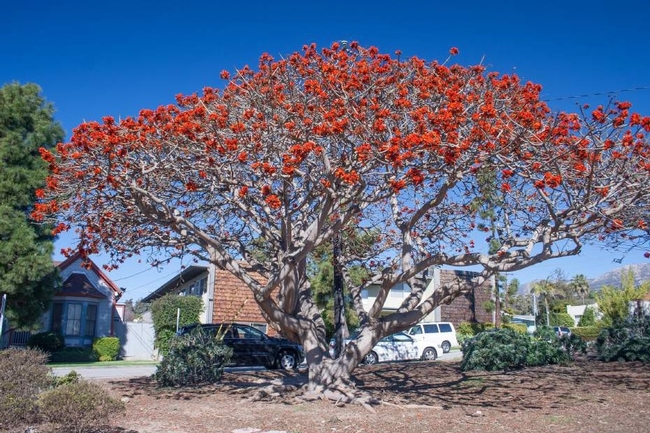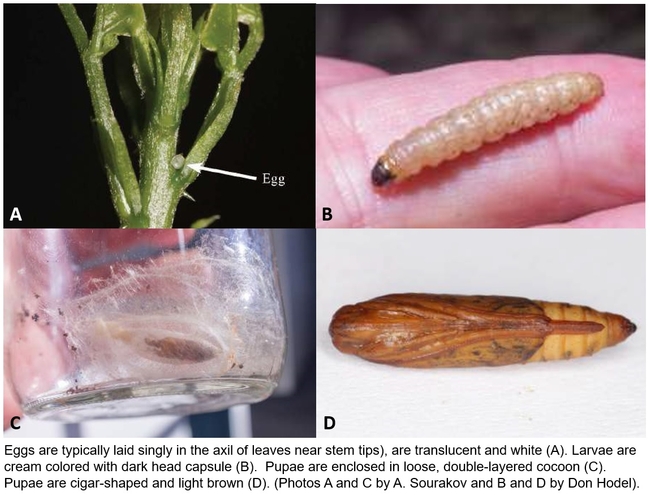Erythrina caffra is a spring-flowering landscape tree. (Photo by Don Hodel)
The Erythrina stem borer (ESB) (sometimes known as the Erythrina twig borer) (Terastia meticulosalis), a potentially devastating pest of Erythrina spp. (coral trees), has been sighted numerous times in southern California in the latter half of 2015 from San Diego to Ventura. Erythrina, a member of the Fabaceae (formerly Leguminosae, bean family) encompasses about 112 species (Bruneau 1996) and includes some of our most useful, valuable, well adapted, and spectacular flowering trees, adorning landscapes along the coast and adjacent plains and valleys in southern California. Indeed, a famous planting of E. caffra adorning the broad median of San Vicente Boulevard in Santa Monica and West Los Angeles was designated an exceptional planting (Hodel 1988). The plethora of sightings suggests a more recent introduction but the ESB was recorded as early as 1973 at Fort Piute in the California desert north of Needles near the southern tip of Nevada (CMSD 2016).
The ESB is of special concern for us because so little is known about its management and it appears to be especially destructive on coral trees, infesting seeds, destroying branch tips, and even killing whole plants. In Florida where it is native, it is a serious pest of naturally occurring and exotic coral trees, which are valued for agriculture, medicine, and landscape ornament (Powell and Westley 1993). Indeed, the cultivation of exotic coral trees in Florida is essentially impossible because of the ESB (Raven 1974); the only coral tree that can be cultivated reliably there is the native Erythrina herbacea, which likely co-evolved with and is found over most of the range of the ESB. In California the ESB has been observed so far on E. × bidwillii, E. chiapasana, E. coralloides, E. crista-galli, and E. falcata; other species will likely be added in the future. Although much remains to be know about the ESB in California, at least at this early stage, the ESB seems to prefer species of coral trees with more lender stems and slender regrowth of larger-stemmed species.
Fortunately, another serious pest of coral trees that is sympatric and co-evolved with the ESB, the Erythrina leaf roller (Agathodes designalis), has not yet been detected in California. The Erythrina leaf roller and the ESB are in closely related genera that have tended to niche-partition the coral tree resource to reduce inter-species competition (Armstrong and McGehee 1980, Sourakov 2011).
Much remains to be known about the natural history of the ESB, and the summary we provide here of its taxonomy, identification, distribution, and life cycle and damage it inflicts on coral trees is mostly from Arakelian (2016), Sourakov (2011, 2012, 2013), Sourakov et al. (2015), and our observations of infested coral trees here.
Taxonomy
The ESB is one of five species in the largely tropical moth genus Terastia, which ranges from the Americas to Africa, Asia, and the western Pacific (Sourakov et al. 2015). The ESB is the only species of the genus native to the Americas. The other four species are T. africana, T. egialealis (Africa), T. margaritis (India), and T. subjectalis (Asia and western Pacific).
Identification
The adult ESB is a small-sized, brownish moth with mottled forewings and whitish hindwings with dark margins. Varying in size, adult forewing wingspans range from 2.5 to 4.6 cm, and the mottled body from 1.5 to 2.5 cm long, the latter with conspicuous knobs toward the posterior (Sourakov et al. 2015). In Florida the ESB varies greatly in size, which largely depends on the seasonal generation and diet. The spring generation, which feeds mostly on seeds, is larger than the fall and summer generation that feeds inside of stems. For example, wingspans of the spring generation average about 3.7 cm while those of the summer and fall generations average about 3cm and 2.5 cm respectively (Sourakov 2011). When at rest, the mottled- or marble-brown forewings are effective at camouflaging the ESB but when the wings are spread the white hind wings are conspicuous. Males and females are similar but the latter has more beige-brown forewing markings. In live specimens, the knobby abdomen is held in a curved, upright position, mimicking a praying mantis head, which is possibly a deterrent to predators (Sourakov et al. 2015). Eggs of the ESB, typically laid singly in the axil of leaves near stem tips, are translucent, white, delicate, dome-shaped with a reticulated surface, and about 0.8 mm long (Sourakov 2012). Young larvae are minute, about 0.5 mm long, and probably burrow directly into the flower, stem, or sometimes even a leaf petiole and then follow it to the stem. Larvae of the ESB are translucent and brownish white or cream-colored with a black sclerotized head and a dark sclerotized prothoracic plate that becomes lighter as the larva matures. Mature larvae are about 4 cm long. Larvae turn pinkish before pupation, especially when they complete their development on seeds. Pupae are cigar-shaped, light brown, and enclosed in a loose, double-layered cocoon (Sourakov 2011).
Distribution
Endemic to the Americas, the ESB occurs from South Carolina to Florida and west to Arizona (and now California) in the United States and south to Argentina. Although recorded from Hawaii (Swezey1923, Zimmerman 1958), this report is now thought to be misidentification. Numerous publications list it as part of African or Asian faunas, but that misconception has been recently clarified (Sourakov et al. 2015), and it seems to be a strictly New World species, with superficially similar but genetically distant relatives in other tropical regions.
Life Cycle and Damage
Larvae of the ESB likely emerge through the ventral surface of the egg and tunnel directly into the plant (Sourakov2012). The downward-boring larvae feed on stem tissues as they go, hollowing out the stem and causing a characteristic dying-off of stem tips, which turn black and sometimes collapse. The entire upper and lateral sides of the plant canopy can be killed. This damage acts like pruning, forcing out new lateral shoots below the damaged area; these, in turn, can become infested and killed. Entire plants can be killed although this can take up to several years. In Florida after killing off stem tips in the spring, the last instar larvae move into seed pods, a condition which appears to be less common in California so far. Feeding on the red seeds typically causes larvae to accumulate reddish pigments, changing their color to pink before they pupate. In contrast, summer and fall generations feed inside the stem and do not feed on the hardened seeds; thus, they are typically paler in color and do not take on the pinkish hue. Larvae typically purge the hollowed out stem of frass by crawling backwards to the entry hole to defecate (Sourakov 2013). Full grown larvae descend from a silk thread to the ground and construct their cocoons in leaf litter to pupate. They have also been found in cocoons in old dead flowers at the ends of dead stems or inside folded up living leaves on the plant (Sourakov 2012). Adult ESBs are good fliers and can hover in flight similar to that of the Sphingidae (sphinx moths) (Sourakov 2012). This flight ability, along with larval endophagous feeding habits that provide some protection from predators, parasites, and abiotic mortality factors, largely explains why the ESB has been so successful in infesting Erythrina plants (Sourakov 2012).
Management
Unfortunately, next to nothing is known about the management of the ESB. Nearly all attempts at post-infestation eradication in Florida have failed. Virtually nothing is known about resident natural enemies although they must be present; until they are identified biological control holds little promise. Perhaps vigilant scouting, judicious and immediate removal, bagging, and disposal of infested shoot tips, and ground and foliar treatment with systemic pesticides might be effective and justified for rare, exceptional, and/or noteworthy and valuable coral tree specimens. Because the ESB pupates in leaf litter on the ground, thorough raking and disposal of fallen leaves might reduce regeneration and provide some control. Cover/barrier insecticides, like pyrethroids (permethrin, cyfluthrin, bifenthrin) or emulsifiable concentrate formulation of carbaryl, might work well in killing of newly hatched larvae when they attempt to bore into the stems; although not yet tested for ESB, they have relatively long residual effects and might be effective. Further work is needed on this pest that poses a serious threat to California's ornamental landscape coral trees.
Acknowledgements
We thank Andrei Sourakov of the University of Florida for reviewing this paper and providing some of the images. Readers interested in supporting his important work can contact Andrei directly (asourakov@flmnh.ufl.edu).
Literature Cited
Arakelian, G. 2016. Erythrina Stem Borer (Terastia meticulosalis). L. A. County Dept. Agri.Comm. /Weights Measures Pest Note.
Armstrong, R. A. and R. McGehee. 1980. Competitive exclusion. Amer. Naturalist 115: 151-170. Bruneau, A. 1996. Phylogenetics and biogeographical patterns in Erythrina (Leguminosae: Phaseoleae) as inferred from morphological and chloroplast DNA characters. Syst. Bot. 21(4): 587-605.
CMSD. 2016. California Moth Specimens Database. On-line: https://essigdb.berkeley.edu/cgi// calmoth_query?stat=BROWSE&query_src=eme_BrowseCalmothNames&where- genus=Terastia. Accessed 5 January 2016.
Hodel, D. R. 1988. Exceptional Trees of Los Angeles. California Arboretum Foundation, Arcadia.
Powell, M. H. and S. B. Westley. 1993. Erythrina Production and Use: A Field Manual. Nitrogen Fixing Tree Association, Paia, HI.
Raven, P. H. 1974. Erythrina (Fabaceae): achievements and opportunities. Lloydia 35: 321-331.
Sourakov, S. 2011. Niche-partitioning, co-evolution and life histories of erythrina moths, Terastia meticulosalis and Agathodes designalis (Lepidoptera: Crambidae). Trop. Lepid. Res. 21(2): 89-94.
Sourakov, A. 2012. On the biology of moths that feed on Erythrina in Florida. Trop. Lepid. Res. 22(2): 110-118.
Sourakov, A. 2013. Erythrina moths Terastia meticulosalis Guenée and Agathodes designalis Guenée. Department of Entomology, Florida Cooperative Extension Service, Institute of Food and Agricultural Sciences, University of Florida, Publ. EENY 516. Available on- line: http://edis.ifas.ufl.edu/in921.
Sourakov, A., D. Plotkin, A. Y. Kawahara, L. Xiao, W. Hallswachs, and D. Janzen. 2015. On the taxonomy of the erythrina moths Agathodes and Terastia (Crambidae: Spilomelinae): Two different patterns of haplotype divergence and a new species of Terastia. Trop. Lepid. Res. 25(2): 80-97.
Swezey, O. H. 1923. The Erythrina twig borer (Terastia meticulosalis) in Hawaii (Pyralidae, Lepidoptera. Proc. Hawaiian Ent. Soc. 5(2): 297-298.
Zimmerman, E. L. 1958. Insects of Hawaii. Vol. 8 (Lepidoptera: Pyraloidea). University of Hawaii Press, Honolulu.
Authors:
Donald R. Hodel is landscape horticulture advisor for the University of California Cooperative Extension in Los Angeles. drhodel@ucanr.edu.
James E. Henrich is curator of living collections at the Los Angeles County Arboretum & Botanic Garden in Arcadia, CA. jim.henrich@arboretum.org.
Kenneth J. Greby is an arborist with ArborPro in Yorba Linda, CA. fastfeat@gmail.com.
Gevork Arakelian is the entomologist with the Los Angeles County Agricultural Commissioner/ Weights & Measures in South Gate, CA. GArakelian@acwm.lacounty.gov.
Linda M. Ohara is a biology sciences lab technician at El Camino College in Torrance, CA, a horticulturist, and a former nurserywoman. lohara@elcamino.edu.
Surendra K. Dara is Strawberry and Vegetable Crops Advisor and Affiliated IPM Advisor for the University of California Cooperative Extension, San Luis Obispo, Santa Barbara, and Ventura Counties, skdara@ucanr.edu.
This article is a reprint of the original article published in the eJournal, PalmArbor.




